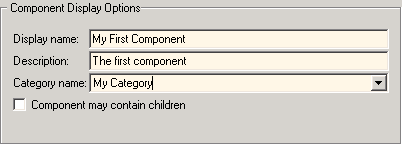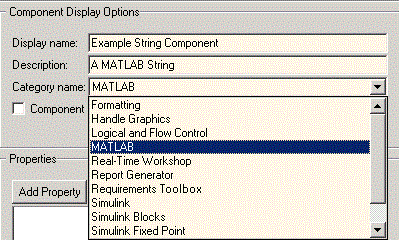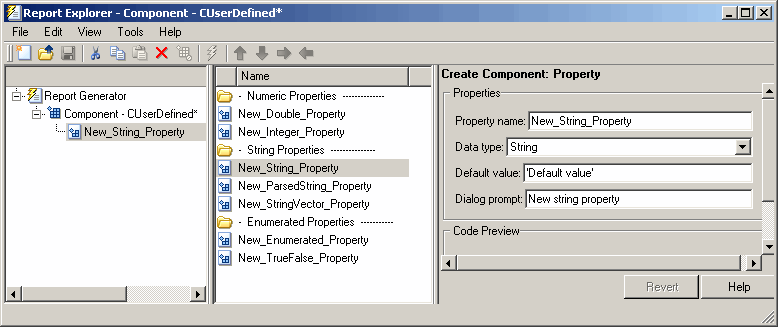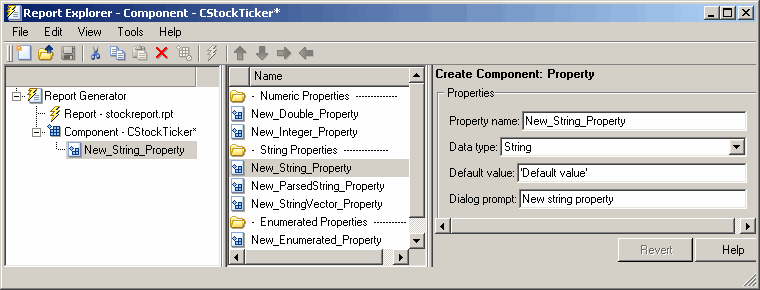定义组件
所需组件数据
创建组件时必须指定以下信息:
指定组件文件的位置
您可以创建执行类似功能的组件,并将它们分组到命名空间目录中。每个命名空间文件夹必须有一个位于 MATLAB® 路径中的父目录。当您构建一个新组件时,MATLAB Report Generator™ 软件会创建组成该组件的文件。这些文件存储在文件夹结构体 <parent>/@namespace_name/@class_name 中。
在属性窗格的组件文件位置区域中的以下字段中指定这些目录:
类目录字段。为您的组件指定一个类名。构建过程会创建一个具有您指定名称的文件夹,并将组件的文件放置在其中。命名空间中每个组件的类文件夹名称必须是唯一的。按照惯例,组件类名以大写或小写字母
c开头;例如,cUserDefinedComponent。名称目录字段。指定用于存储您创建的组件组的文件的文件夹。每个组件的文件都存储在一个子文件夹中,其名称与您在类目录字段中输入的名称相同。
父目录字段。第一次创建命名空间时指定此文件夹。该文件夹是命名空间目录的父文件夹。
设置组件显示选项
您可以通过在属性窗格的组件显示选项区域中输入数据来指定组件在报告资源管理器中的显示方式。输入以下信息:
显示名称。指定组件的显示名称,以便该组件出现在其关联类别的组件列表中。组件类别和显示名称出现在报告资源管理器中间的选项窗格中。
有关指定组件类别的信息,请参阅步骤 3,类别名称。
下面的示例显示如何在名为
My First Component的类别中创建名为My Category的组件。
描述。输入组件的描述。当您点击报告资源管理器中间的选项窗格中的组件名称或类别名称时,就会出现此描述。使描述信息丰富但简短。
类别名称。指定新组件所属的组件类别。该组件出现在报告资源管理器中间的选项窗格中的此类别下。
预定义选项出现在类别名称列表中。从此列表中选择一个组件类别。

要创建自定义组件类别,请在类别名称字段中输入该类别的名称。此类别名称出现在报告资源管理器中的可用类别列表中。

子组件。
如果您希望组件具有子组件,请选中组件可能包含子级复选框。子组件出现在报告资源管理器层次结构中的组件下。在报告生成期间,该组件运行所有子组件并将其输出包含在报告中。
指定组件属性
组件属性决定了组件的行为方式以及它向报告中插入哪些信息。要查看组件属性的当前值,请在报告资源管理器左侧的“大纲”窗格中双击该组件。例如,该图显示了 New_String_Property 的属性值。

向组件添加属性
您可以从属性列表中向组件添加属性。每个属性都有一个默认值,您可以根据需要修改。
有多种方法可以向组件添加属性:
在左侧的“大纲”窗格中,右键点击要添加属性的组件的名称。从上下文菜单中选择添加新属性。

右键点击中间的选项窗格中预定义属性的名称。从上下文菜单中选择添加属性。

左键点击“选项”窗格中的属性名称,然后将其拖到左侧“大纲”窗格中的组件顶部。
双击中间的选项窗格中的属性名称。该属性被添加到组件并且属性值出现在右侧的“属性”窗格中。

点击右侧属性窗格上的添加属性按钮。

指定组件属性
属性名称。为新属性创建一个名称。属性名称必须是有效的 MATLAB 变量名,并且在组件内必须是唯一的。
数据类型。指定属性的数据类型。选项包括:
双精度
枚举
整数
字符向量
由字符向量组成的向量
%<ParsedString>
使用此数据类型将组件中 MATLAB 工作区中的变量的值包含在内。
True/False
默认值。为属性设置一个默认值。默认值必须与数据类型兼容。如果默认值和数据类型之间存在不兼容,则组件可能无法构建。
对话框提示。此文本出现在组件对话框中的小部件旁边。它表明该属性的作用以及它如何影响报告生成。
注意
当组件构建时,冒号会追加到对话框提示字段中的条目。您的条目将显示在“属性”窗格中,并带有冒号。
修改现有组件
报告组件是可修改的。您可以通过双击组件名称并修改其值和属性来从现有组件派生新组件。
构建组件
输入定义组件所需的所有数据后,点击编译组件按钮即可构建它。构建过程会创建组件所需的所有文件并将其存储在指定的文件夹中。有关指定组件存储位置的更多信息,请参阅 指定组件文件的位置。
注意
该位置的现有文件将被覆盖。
重建现有组件
要添加、删除或更改现有组件的属性,请使用重新编译构造函数按钮。仅当您先前使用编译组件按钮创建了组件后,此按钮才会变为活动。要激活重新编译构造函数按钮,请为现有组件指定包名称和类名。这些字段位于属性窗格的组件文件位置区域中。
如果您使用 工具 > 基于以下项创建组件选择一个组件,则该组件的字段将自动填充,并且按钮将变为活动。
完成组件修改后,点击重新编译构造函数按钮重建组件。组件文件夹位置中的可写文件不会被覆盖。
删除组件
要移除组件:
删除其类文件夹 <
root>/@namespace_name/@class_name。如果要删除的组件是命名空间中的唯一组件,请删除整个命名空间。编辑
<root>/@namespace_name/rptcomps2.xml以删除注册该组件的 XML 元素。